
From Despair to Hope
An energetic and progressive Tirana is what we see. Fine places to dine, vibrant shops, parks for strolling, traffic chaos, buildings undergoing facelifts, new structures taking form under a flourish of cranes. Locals tell us Tirana has changed beyond belief from its once austere and dull grey of past decades. The country’s sobering history is evidenced throughout the city in Ottoman, Italian and communist relics. Although only able to skim the surface, my husband Rick and I glean how these major powers gripped the Albanian people.
Tirana – Tanners’ Bridge
One walk takes us to the reconstructed Ottoman-era Tanners’ Bridge, once adjacent to leather workshops and linking Tirana in days gone by to the eastern highlands that supplied the city with agricultural products. Another is Et’hem Bey Mosque, built between 1789 and 1823. Considered a “cultural monument”, it was spared destruction during the later atheism campaign that befell other places of worship.
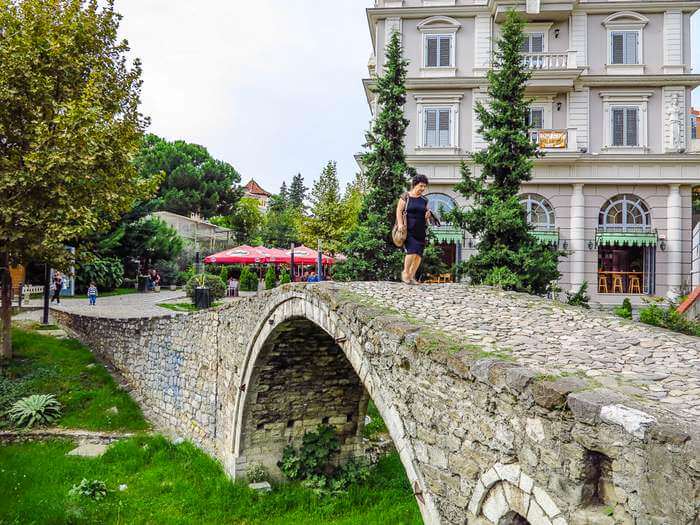
During the Balkan Wars, fought to take over European lands under the Ottoman rule, Albania proclaimed independence in 1912. This achievement was compromised when not long after, Kosovo, which made up a third of Albania, was ceded to Serbia.
Tirana – Albania’s Capital through History
Albania’s “Italian connection” revolved around Ahmed Bey Zogu, who in 1928 declared himself King Zogu I, with Mussolini as a collaborator, which backfired when his Italian ally invaded in 1939. A grand boulevard runs through Tirana divided by Skanderbeg Square; the boulevard bears the name Blvd Zogu I on one side of the square and Blvd Deshmoret e Kombit (Blvd of the Martyrs) on the other. Standing tall in the square is an equestrian statue of Skanderbeg, the Albanian hero who fought against the Ottoman Empire and who King Zogu claimed being a descendent.

Tirana under the Hoxha Regime
A few years after the occupation by Italy, the Albanian Communist Party was founded, led by Enver Hoxha. The party won over the Italians and then the Nazis – beginning 47 years of communism. The life Albanians hoped for was not to be when Hoxha buddied-up to the USSR under Stalin, and followed Stalinist methods of destroying those seen as a threat to the regime.
A yet darker time came when in the 1960’s Hoxha switched his allegiance to the People’s Republic of China. He was quick to implement the Revolutionary doctrines of agricultural collectivism, bans on organized religion, young workers sent off to remote locales to slave for the regime. Tyrant Hoxha died in 1985, but communism continued until the elections in1992.
Bunkerism – Hoxha’s bizarre legacy
Fear of foreign invaders and revolt from his own people drove Hoxha, as a show of strength, to build concrete bunkers that could resist a full tank assault. These concrete domes of various sizes, mostly in sets of three were constructed throughout the country – 500,000 of them (some say as many as 700,000)! They were built mainly from 1976 to 1989 (several years after Hoxha’s death). The drain was stupendous on the country’s finances for such things as social programs, road-building, and infrastructure.

Our bunker hunt takes us to Blloku (The Block), now a trendy shopping area where we enjoy many a cappuccino at neat cafes. Blloku was once exclusive to communist leaders, with a checkpoint to stop commoners from access. Near this old checkpoint we come across a bunker amusingly painted like an orange. Edging a playground about a hundred feet away is another that homeless folks have taken over.
At the National History Museum we are privy to a temporary exhibition of bunker photos from around the country. Many are repurposed, according to their size and where they were built – homes, restaurants, storage, barns, bridges, foundations, the dome of one was even turned over for a family’s swimming pool.
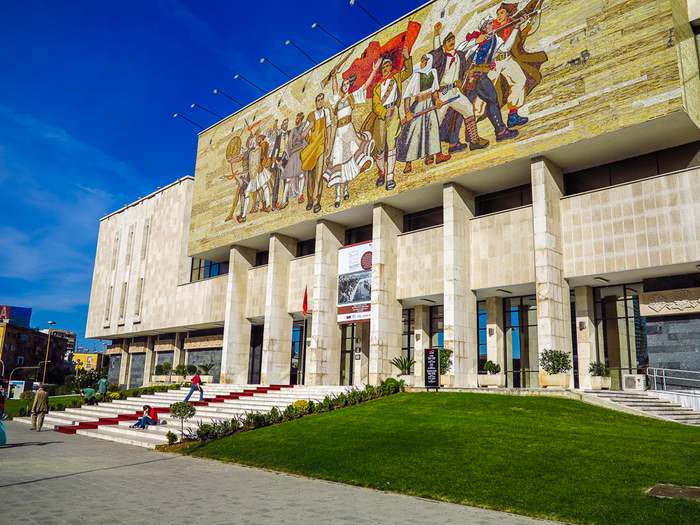
The horror of Hoxha’s regime comes to light in the museum’s “Pavilion of Terror” with scenes and details of how thousands of men and women were swallowed into prisons and labor camps run by Sigurimi (State Security Police).
Another Hoxha-aftermath is the pyramid-shaped Enver Hoxha Museum, built by the dictator’s daughter and son-in-law after his death. With the end of communism its museum use was terminated and for a time it was turned into a convention center and a nightclub farcically named “The Mummy”.
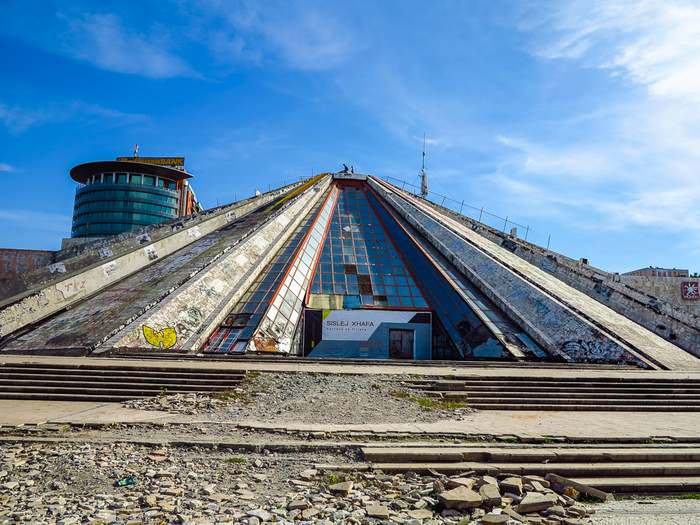
It has since fallen into disrepair. We climb the concrete stairs to its base, and watch youth ascend to the top of the crumbling pyramid like an enormous piece of playground equipment. This monstrosity also serves as a giant graffiti tablet – with profound messages such as – “The world is not for sale.” and “Love Freedom”. A Peace Bell made from thousands of bullet casings hangs in front of the pyramid, the work of school children.
Tirana National Art Gallery
The National Art Gallery beckons. The Soviet-realism paintings are most intriguing – their grand size, bold colors and subject matter dictated. Sturdy women and men are depicted at work in factories, on farms, in mines and other industries where they slaved for the regime; all with “I’m so happy to be here” smiles. We are transfixed by the 1971 painting by Edison Gjergo, “Epic of the morning’s stars”. It was criticized as being too pessimistic; the artist was arrested.

In a small lot back of the gallery are statues from communist times, which had been stored in a shed for years, but “may be restored for their historical significance,” the receptionist at the gallery desk says. As I gaze upon an arm-less Lenin and despot Stalin, the rarity of these statues strikes me – few are still in existence.
Churches of Tirana
New ultra-modern churches and cathedrals are once more part of the cityscapes. Opening in 2012, the Resurrection of Christ Orthodox Cathedral is stunning; we linger in the beauty and tranquility of its interior.
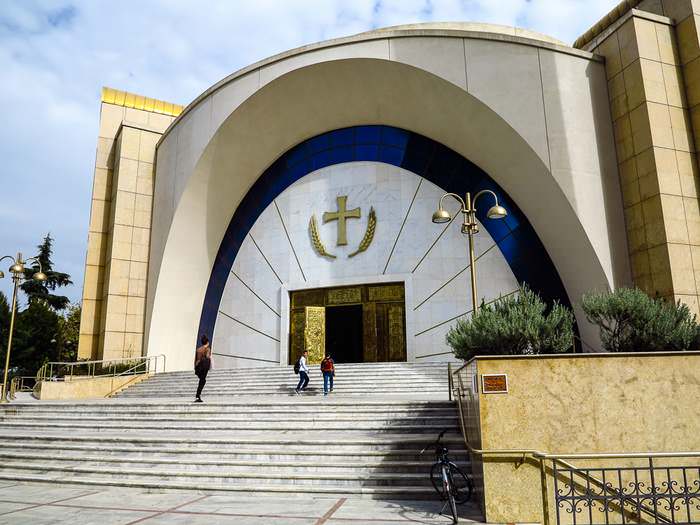
The great and massive Roman Catholic Saint Paul Cathedral was inaugurated in 2000. We peek inside while a mass is going on, not wanting to miss seeing the outstanding stained glass. We move on to find George W Bush Rruga (Street), named in honor of this US President’s visit in 2007.
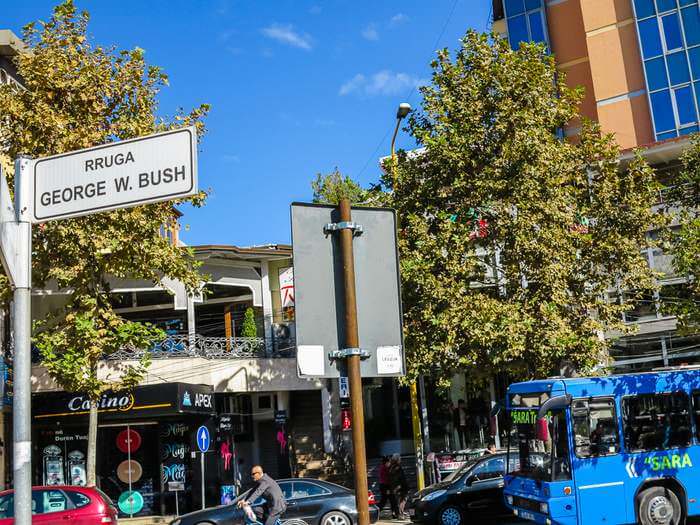
Tirana’s Artificial Lake
When our feet develop blisters we make our way to “Artificial Lake” (yes, this is the formal name of this manmade lake), to sit on a bench by the water and watch families picnicking on the slightly overgrown grass. Squealing children swirl on well-worn rides. Old cronies are perched around a game of dominoes. Roasting corn is in the wind; we join the queue in front of the small vendor and soon are munching sweet crunchy kernels followed by a cappuccino at a lakeside café. A super fun day!
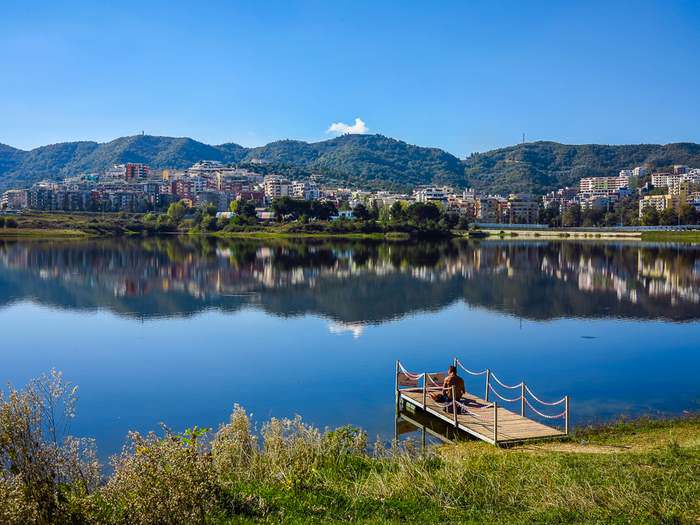
This was a fine way to culminate our Tirana visit. Although the switch from the communist regime to democracy has not been without problems, the resilient citizens are keen to experience the limitless ways to accomplish a good life for their families. Albania is a special place, and we leave with warm feelings from the hospitality shown to us at every turn.
Tirana – If You Go
Tourism Albania
Currency: Albanian lek
Official Language: Albanian
Country Population: 2.774 million (2013) – source World Bank
Tirana Population: 418,495 (2011) – UN data
Where to Stay in Tirana
Tirana International Hotel & Conference Centre
The hotel overlooks Skanderbeg Square
An amazing 5 Star property, yet extremely affordable
Tirana, Albania: From Despair to Hope: Written by Irene Butler and photos by Rick Butler for EuropeUpClose.com
